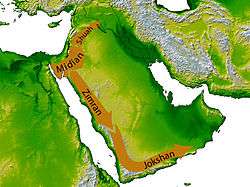Zimran
Zimran (Hebrew: זִמְרָן; "vine dresser; celebrated; song;" Arabic: زيمران), also known as Zambran.[1] was according to the Hebrew Bible the first son of Abraham, the patriarch of the Israelites, and Keturah, whom he wed after the death of Sarah.[2][3] Zimran had five other brothers, Jokshan, Medan, Midian, Ishbak, and Shuah.[4]
Josephus tells us that "Abraham contrived to settle them in colonies; and they took possession of Troglodytis[5] and the country of Arabia Felix, as far as it reaches to the Red Sea."[6] Abraham, in all probability, tried to keep them apart from Isaac to avoid conflict while fulfilling God's commission to spread out and inhabit the globe.[7][8][9] For such reasons Zimran has also been tentatively identified by some with the Arabian town of Zabran, between Mecca and Medina[10] (that is, Jeddah[11]).
According to the Book of Jasher, the children of Zimran were Abihen, Molich and Narim.
Professor Jan Retso and William Hazlitt suggested that the descendants of Zimran are the same people known as "Banizomenes" which were mentioned in the records of the Greek historian Diodorus Siculus.[12] [13]
References
- ↑ Josephus, Flavius, Antiquities, 1.15.1
- ↑ Genesis 25:2-6
- ↑ 1Chronicles 1:32
- ↑ Genesis 25:1-6
- ↑ In this case the word is applied to the cave dwelling peoples of the Rift Valley
- ↑ Josephus, Flavius, Antiquities, 1.15.1
- ↑ Genesis 1:27,28
- ↑ Genesis 9:1
- ↑ Josephus, Flavius, Antiquities, 1.4.1-3
- ↑ Seventh-day Adventist Bible Commentary, Volume 1, Review and Herald Publishing Association (Washington, D.C., USA), 1953, p.367
- ↑ The Edinburgh review: or critical journal, Volume 50, Sydney Smith, Lord Francis Jeffrey Jeffrey, Macvey Napier, Henry Reeve, Sir George Cornewall Lewis, William Empson, Arthur Ralph Douglas Elliot (Hon.) and Harold Cox, A. Constable, 1830, p. 165
- ↑ Arabs in Antiquity: Their History from the Assyrians to the Umayyads, Page 298
- ↑ The Classical Gazetteer by William Hazlit (1851), Page: 67
External links
- Easton's Bible Dictionary: Zimran
